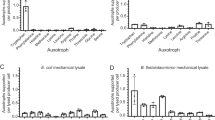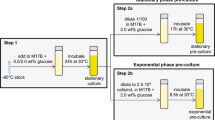Abstract
WHEN a sensitive bacterial cell is exposed to a temperate bacteriophage it may undergo lysis, become lysogenized, or remain uninfected. The relative frequency with which these responses occur depends on the genetic structure of the phage and the conditions of the infection. The outcome may be influenced by temperature1, multiplicity of infection2, and the addition of various chemicals3,4. In a recent paper5, it was reported that glucose added to a nutrient agar medium affected a 100 per cent lysogenic response with Salmonella typhimurium strain LT2 (C + dg s)6 and phage PLT22, while a glucose diauxie-resistant variant of this strain (C + dgr −1)6 was found to be immune to this apparent glucose effect. These conclusions were based on observations of ‘turbid’ or ‘less turbid’ plaques as the criteria for lysogenization or lysis, respectively, of the initially infected cell. Recent attempts to duplicate these experiments were not successful, nor could any glucose effect on the frequency of lysogenization be detected using a more direct and reliable method developed by Luria and Fraser (ref. 4). (We wish to thank E. Bertani for details of the method and the indicator strain.)
This is a preview of subscription content, access via your institution
Access options
Subscribe to this journal
Receive 51 print issues and online access
$199.00 per year
only $3.90 per issue
Buy this article
- Purchase on Springer Link
- Instant access to full article PDF
Prices may be subject to local taxes which are calculated during checkout
Similar content being viewed by others
References
Bertani, G., and Nice, S., J. Bact., 67, 202 (1954).
Boyd, J. S. K., J. Pathol. Bacteriol., 63, 445 (1951).
Lwoff, A., Kaplan, A., and Ritz, E., Ann. Inst. Pasteur, 86, 127 (1954).
Bertani, L. E., Virology, 4, 53 (1957).
Entner, E., and Englesberg, E., Nature, 182, 1808 (1958).
Englesberg, E., Proc. U.S. Nat. Acad. Sci., 45, 1494 (1959).
Adams, M. H., “Methods in Medical Research”, 2, 1 (1950).
Neidhardt, F. C., and Magasanik, B., J. Bact., 73, 253 (1957).
Vogel, H., “Chemical Basis of Development” (Johns Hopkins Press, Baltimore, 1958).
Gorini, L., and Maas, W., “Chemical Basis of Development” (Johns Hopkins Press, Baltimore, 1958).
Author information
Authors and Affiliations
Rights and permissions
About this article
Cite this article
HOFFEE, P., WEINBERG, R. & ENGLESBERG, E. Absence of the Glucose Effect on the Frequency of Lysogenization in Salmonella typhimurium . Nature 189, 160–161 (1961). https://doi.org/10.1038/189160b0
Issue Date:
DOI: https://doi.org/10.1038/189160b0
Comments
By submitting a comment you agree to abide by our Terms and Community Guidelines. If you find something abusive or that does not comply with our terms or guidelines please flag it as inappropriate.



